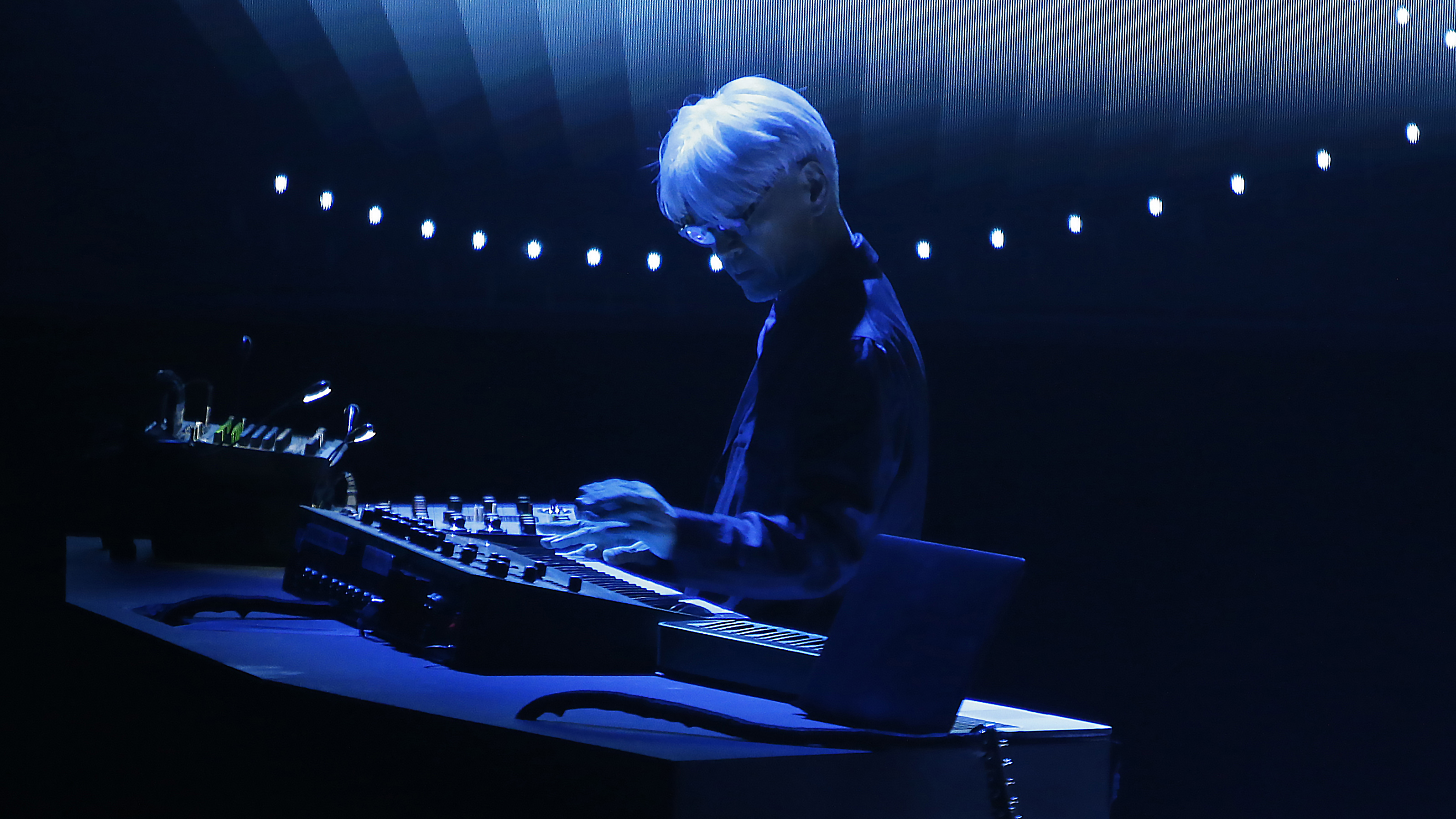
In March this year, the music world lost one of its most influential figures. Ryuichi Sakamoto passed away from cancer at the age of 71, leaving behind a legacy that marks him out as one of the most innovative composers and producers in contemporary music.
Across a career that spanned more than five decades, Sakamoto bridged the divide between the accessible and the avant-garde, inspiring countless artists from all corners of the musical map, from hip-hop to techno to contemporary classical.
Sakamoto was born in 1952, the very same year that John Cage composed the entirely silent piece 4’33, a fact that the experimentally-inclined Sakamoto was often keen to remind interviewers. His affinity for electronic instruments was sparked while studying ethnomusicology in Tokyo, as he tested the boundaries of early synths from Moog, ARP and Buchla. Not long after his studies, Sakamoto formed Yellow Magic Orchestra alongside Haruomi Hosono and Yukihiro Takahashi.
YMO were a pioneering group: one of the earliest pop acts to incorporate synths, sequencers, samplers, and drum machines into their work, they fused influences from Japanese, Chinese and Indian music with new sounds arriving from the West, like Kraftwerk, Giorgio Moroder and early hip-hop. The group were on the cutting edge of musical technology, often picking up and utiliizing state-of-the-art gear as soon as it hit the market.
YMO played a pivotal role in popularising the sound of electronic instruments around the world
They were also lightyears ahead of their time in their approach to sampling, chopping up ‘50s exotica and arcade game sounds on their first international hit, Computer Game. Alongside Kraftwerk over in Berlin, YMO played a pivotal role in popularising the sound of electronic instruments around the world and ushering in the synth-pop era in the United Kingdom.
Sakamoto’s debut solo album Thousand Knives arrived in 1978, the same year the group formed, while B-2 Unit, perhaps his most well-known solo release, came out two years later. Making liberal use of the recently released Roland TR-808 drum machine, the future-facing record sounded like nothing else at the time, and still sounds fresh and experimental four decades later.

Its most influential cut was undoubtedly Riot in Lagos, a visionary synth jam that influenced Afrika Bambataa and Kurtis Mantronik, helping to lay the groundwork for the birth of electro and hip-hop in the United States. Sakamoto continued working on solo material throughout his life, recording over twenty solo studio albums and culminating with the understated but powerful 12, released just two months before his death.
Not only a prolific solo writer, Sakamoto was a natural collaborator, and worked with a variety of artists throughout his career. Perhaps his most notable collaboration was with David Sylvian, of the new wave group Japan, a partnership forged after Sakamoto joined Japan on the 1980 cut Taking Islands In Africa. The pair would go on to form a lifelong friendship, linking up once more for Forbidden Colours, the theme to Merry Christmas, Mr. Lawrence, and Bamboo Houses/Bamboo Music, a 1982 single that charted in the UK.
He later worked with everyone from pop stars (Iggy Pop, David Byrne, Brian Wilson and Peter Gabriel) to cutting-edge electronic artists such as Christian Fennesz, Taylor Deupree, and Carsten Nicolai. Nicolai, who records as Alva Noto, struck up a fruitful creative alliance with Sakamoto after Japanese magazine Code Unfinished commissioned him to remix his material.
The duo went on to score Alejandro González Iñárritu's Oscar-winning The Revenant and record over a dozen collaborative releases, their individual approaches to composition coming together to produce taut, minimal electronic music that stands as a highlight in both artist's discographies.
Though YMO, Sakamoto’s solo work and collaborations garnered a devoted and international following, his musical talents would find their widest audience through his work as a composer for film and television.
Artists that combine this kind of raw talent for pure composition with a mastery of music technology are rare
Winning an Oscar, a BAFTA, a Grammy and two Golden Globe Awards over the course of his career, Sakamoto made a name for himself as one of the pre-eminent film composers of his generation, scoring pictures from some of the most respected directors in modern filmmaking. His first film was 1983’s Merry Christmas, Mr. Lawrence, in which he also starred alongside David Bowie; his final film was Hirokazu Kore-eda’s Monster, which premieres at the Cannes Film Festival later this month.
Influenced by Impressionist composers like Satie and Debussy, Sakamoto had a gift for crafting chords and melodies that slip a hand inside your chest and grab your beating heart. Artists that combine this kind of raw talent for pure composition with a mastery of music technology are rare, but this breadth of capability was key to Sakamoto’s quiet genius.
A lover of both acoustic and electronic instruments, he was equally adept at coaxing breathless beauty from a piano or dialling in jittery synth-funk with a Prophet-5, a synth he named as one of his all-time favourites, along with the ARP Odyssey and EMS Synthi.
While we’ve outlined some highlights here, it’s impossible to stuff more than a sliver of Sakamoto’s illustrious career into just a few paragraphs. If you’re not yet acquainted with the work of this visionary and innovative musician, composer and producer, the tracks we’ve listed below would make an excellent place to start.
1. Yellow Magic Orchestra - Behind The Mask (1979)
One of YMO’s most recognizable tunes, Behind The Mask was originally penned by Sakamoto for a Seiko television ad, only to be re-recorded a year later for Solid State Survivor, the group’s second album.
An electro-pop classic, it runs poet Chris Mosdell’s dystopian lyrics (sung by Sakamoto) through a vocoder, most likely the Roland VP-330. Such was the track’s appeal that both Eric Clapton and Michael Jackson recorded cover versions, the latter almost making it on to Thriller.
2. Ryuichi Sakamoto - Riot in Lagos (1980)
Riot in Lagos is a seminal track in electronic music’s history: its dynamic, mid-tempo groove and wonky synth lines influenced early hip-hop and electro producers in the US. Featuring prominently on Sakamoto’s boldly experimental second album, B-2 Unit, the track was loosely inspired by Afrobeat pioneer Fela Kuti’s kaleidoscopic polyrhythms.
Sakamoto made heavy use of the Sequential Circuits Prophet-10 on Riot in Lagos, co-producing the track with legendary dub producer Dennis Bovell in London.
3. Ryuichi Sakamoto - Bibo No Aozora (1996)
We can’t help but shed a little tear every time we hear this one. Bibo No Aozora first appeared on Sakamoto’s 1995 album Smoochy as a dreamy trip-hop number, but the version we love the most can be found on the album 1996.
Distilling the original into a touching arrangement for piano trio, its gorgeous, melancholic, deceptively simple theme does so much with so little. Check out Jay Electronica’s Better In Tune With The Infinite for an inspired sampling of the track’s central motif.
4. Alva Noto & Ryuichi Sakamoto - Duoon (2002)
Sakamoto's collaboration with Carsten Nicolai has to be one of the most phenomenal link-ups in modern electronic music. Nicolai's subdued, abstract sonics are given a tender brush of colour and emotion by Sakamoto's piano, making for a heart-stopping masterclass in conjuring beauty from the subtlest of elements.
Duoon is a great example of how genius inspires genius, having been sampled by Burial for In McDonalds, an ethereal cut from 2007's Untrue.
5. Ryuichi Sakamoto - andata (2017)
Elegiac and experimental, majestic and austere, andata perfectly captures the essence of the style Sakamoto settled upon in his final decade. Taken from the album async, his first solo record following a 2014 diagnosis of throat cancer, andata is the sound of Sakamoto grappling with his own mortality: the title means ‘gone’ in Italian, and he believed at the time of writing that it might be his final release.
"That’s why I tried to forget all the rules and forms,” he told the New York Times in 2017. “I thought this could be my last one, so I thought I should do everything that I wanted to do.”
6. Ryuichi Sakamoto - Playing the Piano 2022 (2022)
After his initial diagnosis, Sakamoto bravely battled cancer while continuing to work at an astonishing pace. When illness returned in 2021, he remained admirably dedicated to practicing his craft despite the challenges cancer presented.
This solo piano concert, streamed on December 11 2022 from Tokyo's 509 Studio, was his last performance: the stream comprised footage of Sakamoto performing a few pieces each day over the course of a week, in order to preserve his energy. It's an inspiring final glimpse of an artist that was resolutely committed to writing, recording, and performing until the very end.







